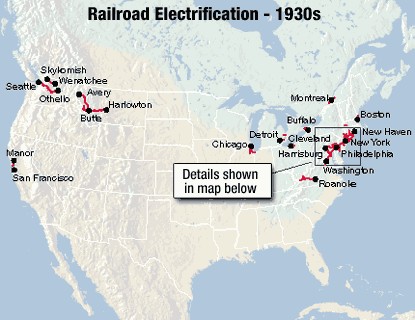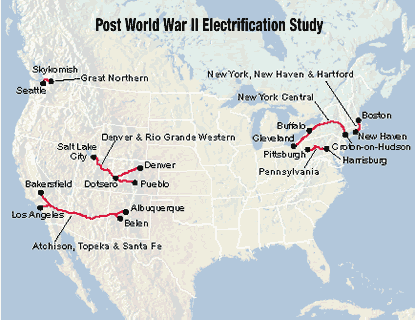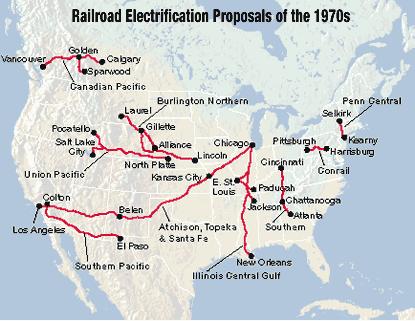Electricity was harnessed for a variety of railroad applications, from high-volume commuter service in crowded cities to heavy-haul freight service in remote mountain areas.
After World War II – and again during the energy crisis of the 1970’s – ambitious studies were developed, often by manufacturers such as General Electric, to introduce or expand electrification throughout the United States, including projects that would have seen entire transcontinental railroad routes under wire.
None of the proposals ever materialized, and much of the existing electrification, particularly in the West, was torn down by the end of the 20th century. What went wrong? In the Spring 2001 issue of Classic Trains, author William D. Middleton looks at the pioneering railroads that electrified their main lines in the 20th century, the surprising plans for expanding electrification across the United States, and the market forces that ultimately doomed main line electrification and secured the triumph of the diesel locomotive.
U.S. railroad electrification at its zenith
Canadian National Railway
Montreal, Quebec Central Station to Cartierville and Deux-Montagnes
Montreal Harbor Commission
Montreal, Quebec Harbor; 19 route miles
Boston & Maine Railroad
Hoosac Tunnel station to North Adams, Mass.; 8 route miles
Boston, Revere Beach & Lynn Railroad
Boston to Lynn and Winthrop, Mass.; 14 route miles
Virginian Railway
Roanoke, Va. to Mullens, W.Va., 134 route miles
Norfolk & Western Railroad
Bluefield to Iaeger, W.Va. and branches to Pocahontas, Duhring, and Wilcoe; 56 route miles
Niagara Junction Railroad
Niagara Falls, N.Y., 11 route miles
Cleveland Union Terminal
Collinwood, Ohio through Cleveland to Linndale; 17 route miles
Illinois Central Railroad
Chicago to Richton, Ill., and branches to South Chicago and Blue Island; 38 route miles
Michigan Central Railroad
Detroit River Tunnel (Detroit, Mich. to Windsor, Ontario); 5 route miles
Canadian National Railway
St. Clair Tunnel (Port Huron, Mich. to Sarnia, Ontario); 4 route miles
Butte, Anaconda & Pacific Railway
Butte to Anaconda, Mont., 37 route miles
Chicago, Milwaukee, St. Paul & Pacific Railroad
Harlowton, Mont. to Avery, Idaho; Othello to Tacoma and Seattle, Wash.; 663 route miles
Great Northern Railway
Wenatchee, Wash. through the Cascade Tunnel to Skykomish; 73 route miles
Northwestern Pacific Railroad
Sausalito, Calif. to Manor, with branches to Mill Valley and San Rafael; 21 route miles
New York City (Woodlawn and Harlem River yard) to New Haven, Conn. and Cedar Hill yard; branches from Stamford to New Canaan, and from South Norwalk to Danbury; 107 route miles
New York Connecting Railroad (operated by the New Haven)
Port Morris to Sunnyside and Fresh Pond, N.Y.; 9 route miles
Long Island Rail Road
Long Island City and Sunnyside in Queens, and Flatbush Avenue in Brooklyn to Port Washington, Mineola, Salisbury Plains, Hempstead, Babylon, Long Beach, and Rockaway Park, N.Y.; 103 route miles
Long Island
Fresh Pond, Queens to Bay Ridge, Brooklyn; 12 route miles
Baltimore & Ohio Railroad
Arlington to St. George to South Beach and Tottenville, Staten Island; 21 route miles
Baltimore & Ohio Railroad
Howard Street tunnel, Baltimore, Md.; 4 route miles
New York Central Railroad
Grand Central Terminal, New York City to Croton-on Hudson, N.Y.; Grand Central Terminal to North White Plains, with a branch to Getty Square (Yonkers); West Side freight line from Spuyten Duyvil to 23rd Street, Manhattan; 70 route miles
Delaware, Lackawanna & Western Railroad
Hoboken, N.J. to Dover; branches from Newark to Montclair and from Summit to Gladstone; 70 route miles
Pennsylvania Railroad
New York City to Philadelphia, Baltimore, Washington and Alexandria, Va.; Philadelphia to Harrisburg, Penn.; Trenton, N.J. to Thornton Junction, Penn.; Parkesburg to Safe Harbor and Harrisburg; Lancaster to Columbia, Penn.; Perryville, Md. to Enola, Penn.; New Jersey branches to South Amboy and Jamesburg; Philadelphia-area branches to West Chester, Norristown, Chestnut Hill, Whitemarsh and Camden; 656 route miles
Hudson & Manhattan Railroad
New York City to Hoboken and Newark, N.J.; 14 route miles
Reading Company
Branches from Philadelphia to Norristown, Chestnut Hill, Doylestown, Hatboro, Penn., and West Trenton, N.J.; 91 route miles
Pennsylvania-Reading Seashore Lines
Camden to Millville, N.J.; 40 route miles
Post World War II
Advances in locomotive technology and electric power distribution created a heightened interest in railroad electrification after World War II. General Electric identified several proposals that would have expanded electrification by over 1200 miles. The expense of electrification and the operating efficiency of diesel-electric locomotives were primary factors in derailing these projects.
Post World War II electrification studies
New York, New Haven & Hartford Railroad
Extend electrification from New Haven to Boston.
New York Central Railroad
Extend electrification from Croton-on-Hudson to Buffalo, N.Y.; later studies looked at extending electrification further west to Cleveland, Ohio.
Pennsylvania Railroad
Extend electrification from Harrisburg to Pittsburgh, Penn.
Denver & Rio Grande Western Railroad
Electrify main line from Pueblo, Colo. to Salt Lake City; also electrify Denver & Salt Railway from Denver to its junction with the Rio Grande at Dotsero, Colo.
Atchison, Topeka & Santa Fe Railway
Electrify main line from Albuquerque and Belen, N.M. to Los Angeles and Bakersfield, Calif.
Great Northern Railway
Extend electrification from Skykomish, Wash. to Seattle.
Considering the 1970s potential
The energy crisis of the early 1970s and the resulting rise in diesel fuel prompted railroads and manufacturers to take another look at electrifying key corridors. Ambitious studies examined the feasibility of electrifying lines on all of the major railroads. Although several short-haul roads were electrified, primarily for the purpose of transporting coal, none of the main line electrification proposals advanced beyond the study stage.
Railroad electrification proposals of the 1970s
Penn Central Company
Extend electrification from Kearny to Selkirk yard outside Albany. N.Y. via the West Shore Line.
Consolidated Rail Corporation
Extend electrification from Harrisburg to Pittsburgh, Pa.
Southern Railway
Electrify line from Cincinnati, Ohio to Chattanooga, Tenn., and beyond to Atlanta, Ga.
Illinois Central Gulf Railroad
Electrify main line from Chicago to New Orleans, plus branches to East St. Louis, Ill., Paducah, Ky., and Jackson, Tenn. ICG did in fact extend its overhead catenary from Richton to University Park in 1974.
Burlington Northern Railroad
Electrify line from Laurel, Mont. over Crawford Hill to Lincoln, Neb., plus a loop serving the Powder River coal line and arteries from Gillette, Wyo. to Orin, then east to Northport, Neb. and Alliance. A later study reduced the scope of possible electrification to 360 miles between Alliance and Lincoln.
Union Pacific Railroad
Electrify main line from North Platte, Nebr. to Salt Lake City and Pocatello, Idaho.
Atchison, Topeka & Santa Fe Railway
Electrify entire Chicago to Los Angeles main line.
Southern Pacific
Electrify the Sunset Route between El Paso, Texas and Colton, Calif.
Canadian Pacific Railway
Electrify main line from Calgary to Vancouver, plus a branch from Golden, B.C. to mine loadouts at Sparwood.
For more about the electrification of railroads in this country read the cover story article “Electrics in the Diesel Age” in the Spring 2001 issue of Classic Trains magazine.

















The PRR listing shows electrification from Trenton, N.J. to Thornton Junction, Penn. This should read Trenton, N.J. to Thorndale, Penn.
This is all well and good but diesel power gives you the electric motors to provide smooth traction without the expenes of stringing and maintaining catenary.